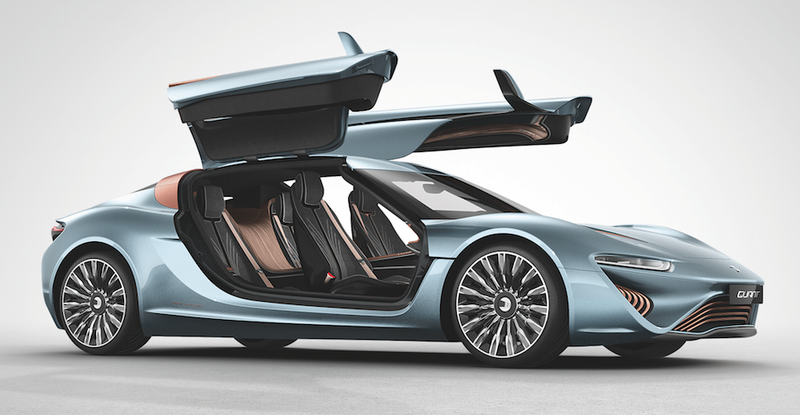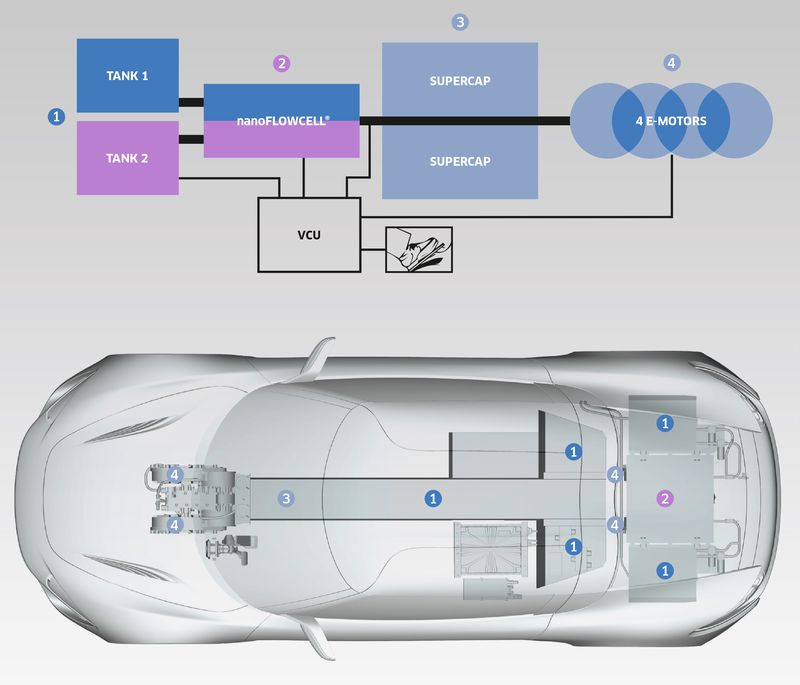Salt Water-Powered Car
nanoFLOWCELL unveils flow cell battery prototype vehicle
Liechtenstein-based nanoFLOWCELL unveiled the QUANT e-Sportslimousine, a prototype vehicle equipped with a nanoFLOWCELL flow cell battery powertrain, at the Geneva Motor Show. This flow cell system supports an electric driving range of between 400 to 600 km (249 to 373 miles) in the QUANT e-Sportlimousine prototype, the company claims.
Flow cells or flow batteries combine aspects of an electrochemical battery cell with those of a fuel cell. The electrolytic fluids in flow cells—usually metallic salts in aqueous solution—are pumped from tanks through the cell. This forms a kind of battery cell with a cross-flow of electrolyte liquid. One advantage of this system in general is that the larger the storage tanks for the electrolyte fluid are, the greater the energy capacity. Too, the concentration of an electrolytic solution contributes to the the quantity of energy that it transports.
To charge or discharge the nanoFLOWCELL, two different electrolytic solutions are pumped through the appropriate battery cell in which an electrode (anode or cathode) is located. A membrane separates the two electrolyte chambers and their differing chemistries. At a nominal voltage of 600 V and 50 A nominal current, the system in the lab is achieving continuous output of 30 kW.
According to nanoFLOWCELL, its flow battery has a specific energy of about 5-times that of a Li-ion battery (600 Wh/kg compared to ~120 Wh/kg). The company attributes the performance of the nanoFLOWCELL to the characteristics of its newly-developed, and unspecified, electrolytic fluids, made up of metallic salts at very high concentration. Slightly more specifically, the company says that a large increase in the number of charge carriers in the electrolyte fluid within the nanoFLOWCELL significantly increased its performance compared to conventional redox flow-cells (about 5x the specific energy and several orders of magnitude more specific power).
The company also claims its flow cells can go through 10,000 charging cycles wi th no noticeable memory effect and suffer almost no self-discharging.
th no noticeable memory effect and suffer almost no self-discharging.
The first QUANT e-Sportlimousine prototype carries two 200-liter (53 gallons US) tanks on board, for a total energy capacity of 120 kWh. The QUANT e-Sportlimousine energy consumption is about 20 kWh/100 km, when driving in the lower load range. Increasing the tank volume of the QUANT e-Sportlimousine to 800 liters would be possible, the company says.
Once the electrolytic fluids are discharged, the contents of both tanks must to be replaced. The prototype features a double tank system with dual filler necks, one for each electrolyte, to keep times for the electrolyte liquid replacement to a minimum.
Powertrain. In addition to the flow cell, the QUANT uses four electric motor units (120 kW continuous, 170 kW peak per unit) for all-wheel drive with torque vectoring and two supercapacitor banks for energy storage. Peak torque per wheel is 2,900 N·m (2,139 lb-ft). The company says acceleration from 0 to 100 km/h is 2.8 seconds.
A central VCU (vehicle control unit) is responsible for controlling the driving- and charging-currents throughout the entire powertrain.
The supercaps provide power to the four drive motors, and also serve as a general energy buffer for the vehicle’s electrical system and storage for regenerative braking energy.
In February, nanoFLOWCELL AG announced a partnership with Bosch Engineering GmbH to further develop vehicle electronics for the QUANT e-Sportlimousine.
According Nunzio La Vecchia, the head of development of the QUANT e-Sportlimousine, the company is planning on producing four drivable prototypes in 2014.
Established in late 2013, nanoFLOWCELL AG (formerly JUNO Technology Products AG) is a Research and Development Centre based in Vaduz, Liechtenstein. The focus of nanoFLOWCELL AG’s research is on the advanced development of drive technology and the classification of flow-cell technology. In 2009, the company showed the NLV Quant prototype at the Geneva Motor Show. The QUANT e-Sportslimousine is a completely new development, both technically and optically, compared to the NLV Quant.
===========================



